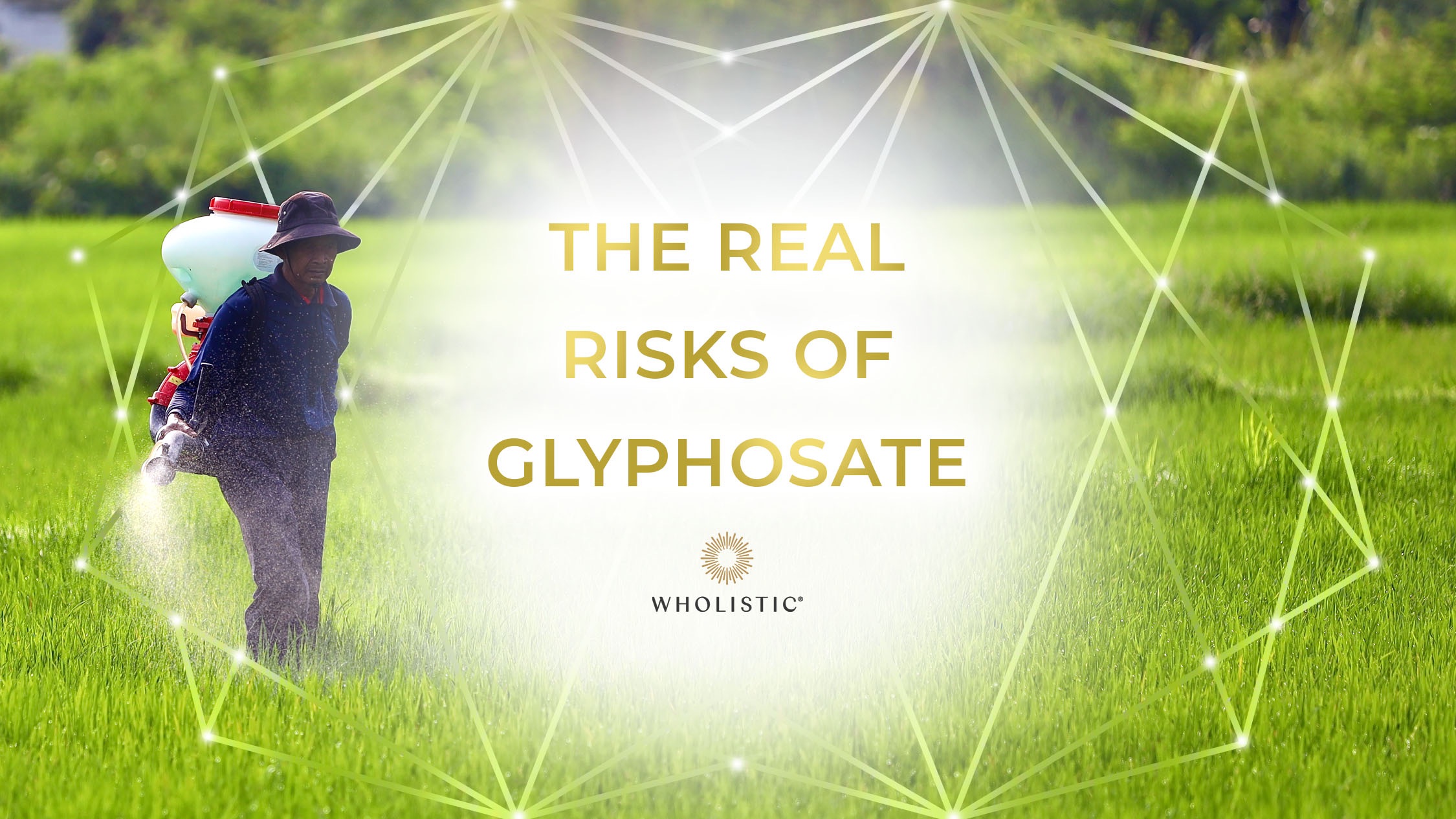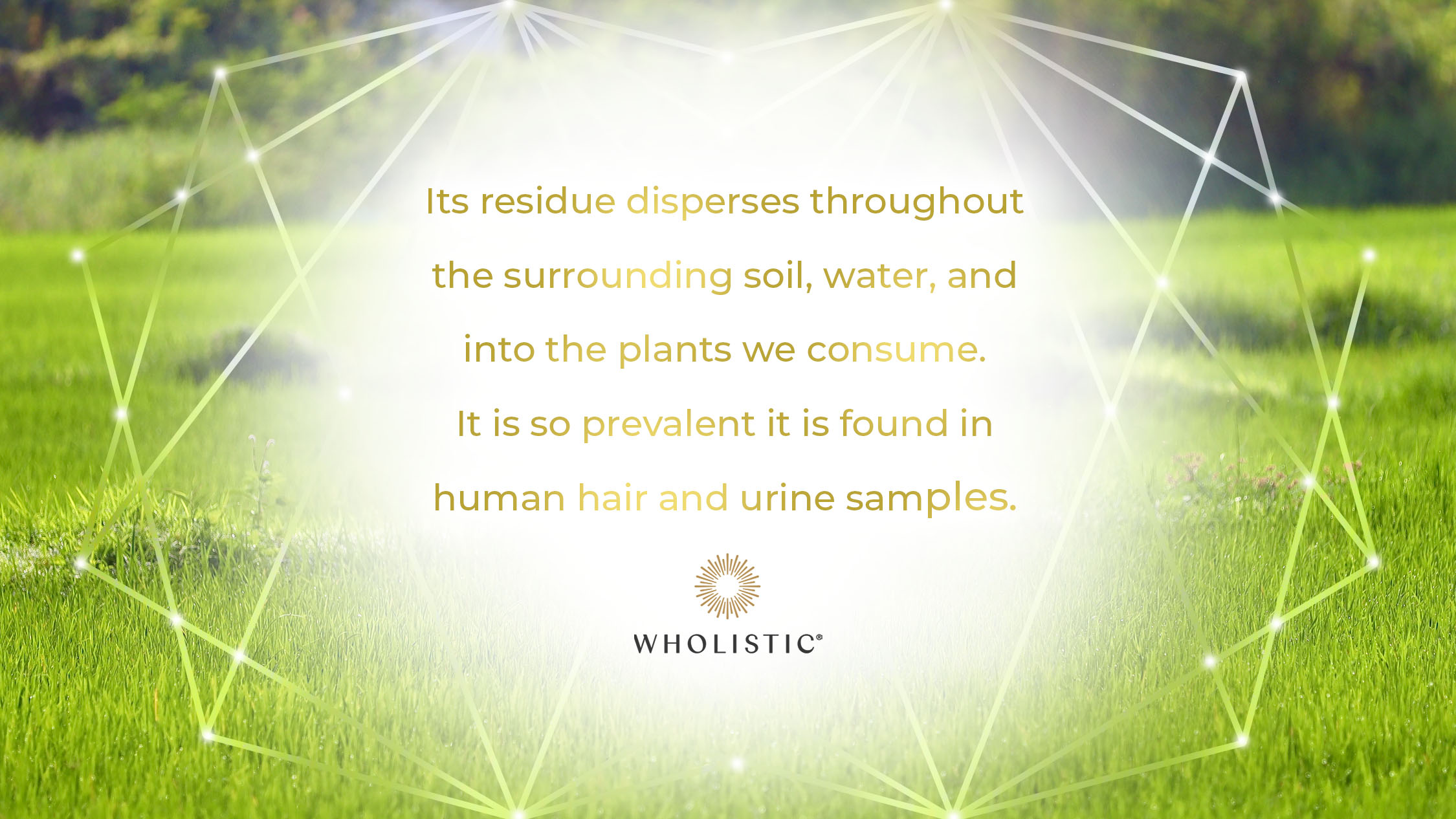The Real Risks Of Glyphosate

If you’re like me, you find peace and satisfaction in cultivating your own garden. There’s something special about watching the fruits of your labor grow. You might also be familiar with the frustration of keeping weeds and bugs from harming your plants…
That’s why so many companies, from landscaping companies to consumer packaged goods companies, turn to weed-killer products for help. You are probably spending time in public spaces that use them, eating foods that have been sprayed with them, or drinking water that is contaminated with them…
Today, I want to raise awareness about glyphosate, a popular herbicide found in weed-killing products. Glyphosate is sprayed over a massive amount of crops such as corn, soy, and wheat. These plants are genetically engineered to be unaffected by the application of glyphosate, while the wild weeds around it die away.
We’ll explore the impact glyphosate can have on the human body and the environment, including:
- What is glyphosate
- The potential risks you should be aware of
- 3 simple solutions for minimizing your exposure to glyphosate
Increasing your knowledge of this topic can help guide your daily choices, accelerate research efforts, and influence consumer packaged goods companies to get glyphosate out of the food supply.
What Is Glyphosate?
Glyphosate is a broad-spectrum systemic herbicide, usually mixed with other chemicals and sprayed over yards and fields to curb the growth of weeds. It has increasingly grown in popularity and usage. Today, glyphosate is the most commonly used herbicide around the globe.
Research shows that prolonged exposure to the chemical could adversely impact your health and the health of the environment. The use of glyphosate is yet another way companies are harming the planet for the sake of convenience and making a profit.
There is consistent concern about chronic exposure to glyphosate and the other ingredients often mixed with it to help it get into plants, which can cause mild to severe health issues. You may already be aware of the recent lawsuit against RoundUp, a major glyphosate-based product, and the allegations that RoundUp exposure causes cancer.
Although the scientific community hasn’t officially reached a consensus on the linkage between glyphosate and cancer yet (1), understanding the scope of glyphosate contamination in our food supply is critical to protecting public health because research is not being done with environmentally relevant concentrations of glyphosate.

The Potential Risks Of Glyphosate Exposure
Here are just a few ways prolonged exposure to glyphosates can impact your health:
- Ingestion of large amounts may result in damage to the heart, kidney, and liver
- Inhalation may irritate the lungs and cause difficulty breathing (2)
- Studies show exposure disrupts the endocrine system, leading to improper hormone production
- Research linked high glyphosate exposure to a 41% increase in risk for developing non-Hodgkin lymphoma (3)
- High exposure could:
- Promote neurological disease development
- Reduce hemoglobin concentration (leading to mild anemia)
- Reduce phagocytosis (which is the body’s immune response to foreign substances such as bacteria)
- It may trigger oxidative stress, which is an imbalance between free radicals and antioxidants in your body (4)
Although you would not seek out glyphosate and consume it on purpose - there is no escaping ingestion of it if you eat most commercially manufactured corn, wheat, oat, barley, bean, or soy-based products or drink tap water.
Once glyphosate is applied to crops, lawns, and gardens, its residue disperses throughout the surrounding soil, water, and into the plants we consume. It is so prevalent it is found in human hair and urine samples.

Here are some facts about how prevalent glyphosate is in our environment, in our bodies, and in our food:
- Glyphosate binds tightly to soil and can be detected for up to 6 months depending on the climate and the type of soil it is in (5)
- Glyphosate has been detected in rain samples, exceeding amounts previously detected - no associations were observed between soil and rainwater concentrations in the same monitoring areas despite the fact that treated soil is the primary source (6)
- Every study that has measured for glyphosate residues in human urine has found it. In June 2022, the CDC published a massive study that showed more than 80% of urine samples drawn from children and adults in a US study contained glyphosate (7)
- According to the National Agricultural Statistics Service, in 2021, approximately 32 million pounds of glyphosate was applied to corn grown in the U.S. I am linking the PDF in the References section below so you can see for yourself. You can actually look up the chemicals used on US crops through this annual Agricultural Chemical Use Survey and keep in mind, this just represents the amounts being officially reported… the 32 million pounds is just the amount for corn and there are tens of millions of pounds more being used on other crops (8)
- The Environmental Working Group tested and found glyphosate in more than 95 percent of popular oat-based food samples (9)
- According to The Detox Project some of the highest levels of glyphosate found by third party testing were actually found in food labeled “non-GMO” (10)
Most of us will only experience “residual exposure” to glyphosate but there is not enough research yet to confirm what levels of exposure increase health risks to a verifiable degree. It’s up to us to decide whether we want to roll the dice on our exposure to this compound.
3 Ways To Reduce Glyphosate Exposure
Glyphosate is not an ingredient you can look for on the back of any label in the grocery store. While it is impossible to eliminate every possible exposure to glyphosate, the good news is - you can minimize your exposure to glyphosate by making just a few simple and safe choices.
Here are 3 ways you can reduce your exposure to glyphosate:
- Choose organic products or products that are certified Glyphosate Residue Free whenever possible and always wash your produce well before consuming. Here is the link to companies that are Glyphosate Residue Free. (7)
- Speak out about the use of glyphosate to your local representatives and to companies directly. Our voices make a difference. Some regions are already committing to phase out the use of glyphosate as a desiccant and companies are making efforts to achieve the Glyphosate Residue Free certification. Even Kellogg has said they will phase out glyphosate by 2025. (10)
- Before drinking from the tap, test your drinking water for glyphosate because permitted levels in tap water reach 700 parts per billion in the US, which is quite high. (7)
The benefit of staying informed and making informed choices allows you to sustain a healthy life for yourself and your family!
Keep in mind that knowledge like this can help light a fire within. You can nurture the spark into motivation to commit to your inner work and cultivate a harmonious state of consciousness. It’s such a critical time for us to reprogram our belief systems so we can more easily access answers to issues like this one, rise up from the broken systems that surround us, and help build a better system based on love.
From a balanced inner state, you can more easily access the answers that will help our planet and help us all move forward.
Tune In: Be The Hero Of Your Health Podcast
The risks of glyphosate was a recent topic of discussion on my latest podcast series: Be The Hero Of Your Health. This illuminating series empowers you to awaken the superhero within and take responsibility for your health, especially when it comes to the foods you nourish your body with.
Check out the extensive library of podcast episodes so you can learn to see through the illusions of deceptive marketing and understand how certain ingredients can impact your health. With this valuable knowledge, you can feel empowered to make healthy choices for life!
Listen Now
References:
- Soares D, Silva L, Duarte S, Pena A, Pereira A. Glyphosate Use, Toxicity and Occurrence in Food. Foods. 2021 Nov 12;10(11):2785. doi: 10.3390/foods10112785. PMID: 34829065; PMCID: PMC8622992
- Beata M. Kolakowski, Leigh Miller, Angela Murray, Andrea Leclair, Henri Bietlot, and Jeffrey M. van de Riet Journal of Agricultural and Food Chemistry 2020 68 (18), 5201-5211 DOI: 10.1021/acs.jafc.9b07819
- https://www.sciencedirect.com/science/article/abs/pii/S1383574218300887
- Cindy Peillex & Martin Pelletier (2020) The impact and toxicity of glyphosate and glyphosate-based herbicides on health and immunity, Journal of Immunotoxicology, 17:1, 163-174, DOI: 10.1080/1547691X.2020.1804492
- http://npic.orst.edu/factsheets/glyphogen.html
- https://pubmed.ncbi.nlm.nih.gov/30015122/
- https://detoxproject.org/glyphosate-in-food-water/
- https://www.nass.usda.gov/Surveys/Guide_to_NASS_Surveys/Chemical_Use/
- https://www.ewg.org/news-insights/news/glyphosate-contamination-food-goes-far-beyond-oat-products
- https://www.foodnavigator-usa.com/Article/2022/02/22/New-report-alleges-mass-contamination-of-foods-from-use-of-glyphosate-to-dry-crops#
Discover Three Powerful Ways to Bring Health & Vitality Into Your Everyday Life in This FREE Masterclass by Worldwide Master Practitioner In Wholistic Healing, Elena Bensonoff.
Sign Up for the Masterclass below:






